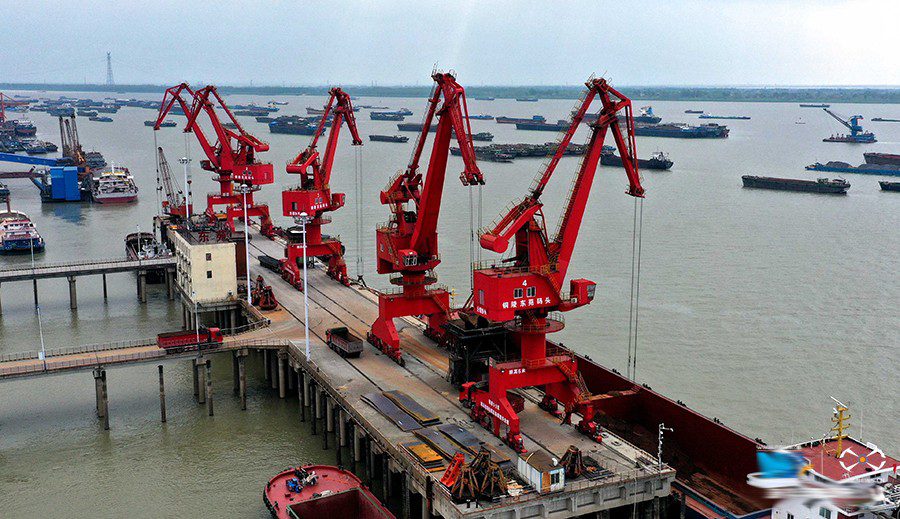1. Port and Terminal Information
1.1 Tongling Port operates 24/7, with terminals handling bulk cargo (coal, minerals), containers, and general cargo. Main terminals include:
– Tongling Nonferrous Metals Terminal: Depth 10.5m (CD), max LOA 200m, 2 berths (No.1 & No.2), max draft 9.8m, equipped with 4 gantry cranes (25t capacity each)
– Tongling Container Terminal: 2 berths (Depth 12m), 3 STS cranes (50t SWL), annual throughput capacity 500,000 TEU
– Tongling General Cargo Terminal: Depth 8.5m, max LOA 150m, restricted to non-hazardous cargo, 2 mobile cranes (100t capacity)
– Tongling South Port Expansion Phase 1 (30°52’N 117°49’E): Operational since Q3 2023, 1 bulk berth (Depth 11m, LOA 220m), dedicated for coal exports
1.2 All terminals require 24-hour advance notice for berth allocation via Port VHF CH06 or email to tonglingport@portauthority.cn
1.3 New addition (2024): Night navigation lights upgraded to LED system (IALA compliant) for all approach channels
2. Navigation and Channel
2.1 Main channel depth maintained at 7.5m (datum CD), with tidal range up to 3.2m during spring tides
2.2 Mandatory requirements:
– AIS transmission within 5nm radius from 30°56’N 117°47’E
– Updated ENC charts (China Hydrographic Office CH-1802 edition 2024)
– VHF radios with dual watch (CH16 and working channel)
2.3 Navigation restrictions:
– Night navigation prohibited for vessels >10,000 DWT without pilot approval
– Speed limit: 8 knots within inner harbor (buoy No. T1-T12)
– VLCCs restricted to daylight hours only
2.4 Revised (2024): Channel dredging completed in Q1 2024 – updated depths available via NAVTEX (MSI broadcast) or port website (www.tonglingport.gov.cn/hydro)
3. Anchorage Regulations
3.1 Designated anchorage areas:
– No.1 Anchorage (30°55’N 117°45’E): Max 5 vessels, depth 15m, priority for vessels >5,000 GT
– No.2 Anchorage (30°53’N 117°48’E): Hazardous cargo only, max 3 vessels, 24h surveillance
– Emergency Anchorage (30°54’N 117°47’E): Reserved for vessels in distress (MSA approval required)
3.2 Operational requirements:
– Anchoring outside designated zones requires Port Control permission (VHF CH12)
– Anchorage holding capacity tests mandatory for vessels >20,000 DWT (submit report 6h before arrival)
– Vessels at anchor must maintain engine readiness (max 1h notice for movement)
3.3 New regulation (2024): Mandatory anchor watch rotation records (4-hour intervals) for PSC inspections
4. Pilotage Requirements
4.1 Compulsory for:
– All foreign-flagged vessels
– Domestic ships >3,000 GT
– Vessels carrying Class I hazardous cargo (IMDG Code)
– VLOCs and VLCCs regardless of tonnage
4.2 Pilot operations:
– Boarding point: 30°54.5’N 117°46.2’E (updated 2023)
– Transfer hours: 0600-1800 local time (extended with prior notice)
– Minimum 6-hour notice required via VHF or +86-562-1234567
4.3 Equipment standards:
– Pilot ladder compliance with SOLAS Reg. V/23 (2023 amendments)
– Combination ladder required for freeboard >9m
– Illumination at night (minimum 50 lux at ladder position)
5. Cargo Operations
5.1 Bulk cargo handling:
– Coal loading: Dust suppression systems mandatory, max rate 5,000 MT/hour
– Mineral concentrates: Moisture content certification required (BC Code compliance)
– Grain operations: Fumigation certificates must be presented 24h prior
5.2 Hazardous cargo:
– IMDG Code compliance certificates (48h prior notice)
– Stowage plan approval from Tongling MSA (+86-562-12395)
– Dedicated safety officer required onboard during operations
5.3 Container operations:
– VGM declaration required before loading
– Mandatory RFID tags for hazardous containers (GB 12345-2023)
– Reefer monitoring: Temperature logs must be submitted hourly
5.4 New requirements (2024):
– Digital cargo manifests (XML format) for customs clearance
– Mandatory use of anti-slip coatings for steel cargo
6. Safety Regulations
6.1 Fire Safety:
– Minimum 4 certified firefighting crew members onboard
– Monthly drills with documented reports (MSA Form F-103)
– CO2 system inspection certificates valid within 12 months
6.2 Emergency Preparedness:
– Port Control: VHF CH16/CH13 (24/7 monitoring)
– Maritime Safety Office: +86-562-12395 (emergency line)
– Designated hospital: Tongling People’s Hospital (+86-562-120)
6.3 Operational Safety:
– Gangway requirements: Illuminated (50 lux min), safety nets, 24h watch
– Enclosed space entry permits for all cargo holds
– Hot work permits required from Port Authority
7. Environmental Compliance
7.1 Discharge Regulations:
– Zero discharge within 12nm (MARPOL Annex V enforced)
– Sewage treatment records for last port required
7.2 Air Emissions:
– 0.5% sulfur cap at berth (China ECA regulations)
– Real-time monitoring for vessels >10,000 GT (from July 2024)
7.3 Waste Management:
– Mandatory use of port reception facilities
– Hazardous waste manifests (IMO Form 5.1)
– Oil record book inspections (random by MSA)
8. Special Notices
8.1 Typhoon Procedures:
– Signal No.8: Immediate berth evacuation
– Hourly updates on VHF CH16
– 2-hour anchor checks during alerts
8.2 Winter Operations:
– Deck anti-icing measures required
– -5°C threshold for reduced operations
8.3 Fog Navigation:
– <500m visibility: Pilot approval required
– VLOCs: Radar-assisted berthing only
8.4 New (2024):
– Cyber security protocols for ECDIS updates
– Digital crew health declarations (China Maritime APP)
9. Documentation Requirements
9.1 Mandatory Certificates:
– Original P&I Club certificates
– Updated crew list (24h prior arrival)
– Vaccination records (if applicable)
9.2 Customs Clearance:
– Digital manifests (XML format)
– Cargo documentation in Chinese/English
9.3 New (2024):
– Electronic bills of lading acceptance
– Digital port clearance certificates
10. Port Services
10.1 Bunkering:
– Licensed suppliers only (approved list)
– 12h notice for barge arrangements
10.2 Provisions:
– CIQ inspection for fresh food
– 12h quarantine notice
10.3 Repairs:
– Approved contractors only
– Hot work permits required
11. Additional Critical Notices
11.1 Crew Changes:
– 72h immigration notice
– COVID-19 testing waived (MSA 2024-12)
11.2 Port State Control:
– Targeted inspections (>3 deficiencies)
– 2024 CIC on Fire Safety Systems
11.3 Security:
– ISPS Level 1 maintained
– Restricted areas clearly marked






